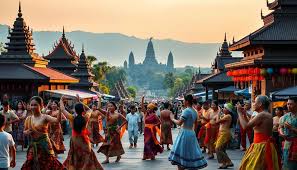Festivals & Rituals at Phra That Chae Haeng | Sacred Buddhist Temple Thailand
A Sacred Legacy in Nan Province
Phra That Chae Haeng is one of the most revered Buddhist temples in Nan Province, Northern Thailand. Built in the 14th century, this golden stupa rises gracefully on a hilltop, symbolizing spiritual devotion and centuries of Buddhist heritage. More than just a historic site, the temple is a living center of faith where festivals and rituals play an essential role in uniting the local community and attracting pilgrims from across Thailand and beyond.
The Spiritual Importance of Festivals
Festivals at Phra That Chae Haeng are deeply connected to Buddhist teachings and the rhythms of traditional Thai life. These celebrations are not only religious ceremonies but also cultural gatherings that highlight local identity. They provide opportunities for merit-making, paying homage to the Buddha, and reinforcing communal harmony. Every ritual, from offering alms to candlelight processions, carries layers of symbolic meaning that have been passed down through generations.
Annual Festivals That Define the Temple
Several key festivals stand out in the temple’s yearly calendar:
1. Phra That Chae Haeng Festival
Held in the 12th lunar month, this grand festival is one of the most important celebrations in Nan Province. Pilgrims gather to walk around the gleaming golden stupa, offering flowers, candles, and incense. Monks chant sacred texts, and laypeople make merit by presenting robes, food, and donations. The air fills with the sound of temple drums and traditional Lanna music, creating a deeply spiritual yet festive atmosphere.
2. Makha Bucha Day
This nationwide Buddhist holiday commemorates the spontaneous gathering of 1,250 monks to hear the Buddha preach. At Phra That Chae Haeng, devotees join candlelit processions around the stupa, circling it three times to symbolize reverence for the Buddha, the Dharma (teachings), and the Sangha (monastic community). The glowing lights against the golden chedi create a breathtaking spiritual scene.
3. Visakha Bucha Day
Marking the Buddha’s birth, enlightenment, and passing into Nirvana, Visakha Bucha is celebrated with meditation, sermons, and merit-making. Families often come together to donate food to monks and release birds or fish as symbolic acts of compassion and liberation.
4. Loy Krathong Festival
Although more widely associated with rivers and lakes, Loy Krathong at Phra That Chae Haeng carries its own charm. Devotees release beautifully decorated floating offerings, called krathongs, into nearby waters as a way of paying respect to the river spirits and letting go of negativity. At the temple, lanterns illuminate the night sky, blending faith with visual splendor.
5. Songkran (Thai New Year)
Songkran is both a joyful and sacred time. Locals and visitors pour scented water over Buddha images and onto the hands of elders as a blessing and gesture of respect. At Phra That Chae Haeng, the temple grounds come alive with rituals of renewal, where cleansing symbolizes purification of the past year and preparation for the year ahead.
Rituals That Connect Past and Present
Beyond annual festivals, daily and seasonal rituals keep the temple’s spiritual heartbeat alive. Early each morning, monks walk barefoot to receive alms from villagers, while in the evenings, prayers and chanting echo through the temple halls. Pilgrims often perform wai phra—bowing and offering lotus flowers—before the sacred stupa. During special occasions, devotees may also join in tamboon (merit-making) ceremonies, which are believed to bring blessings for health, prosperity, and spiritual growth.
Cultural Identity and Community Spirit
What makes the festivals and rituals at Phra That Chae Haeng unique is how they intertwine faith, culture, and community. Traditional Lanna music, folk performances, and local food stalls often accompany temple events, turning them into cultural fairs as much as spiritual observances. The temple thus serves as both a religious sanctuary and a cultural hub where traditions are celebrated and preserved.
A Living Heritage for Visitors
For travelers, attending a festival or ritual at Phra That Chae Haeng is a chance to witness Thai Buddhism in its most authentic form. It is not just about seeing a golden stupa but experiencing the devotion of local communities, the rhythms of chanting, the fragrance of incense, and the sight of thousands of candles glowing in unity. Visitors are often welcomed to join in respectfully, whether by offering alms, participating in processions, or simply observing in quiet reverence.
Conclusion
Phra That Chae Haeng is more than a sacred Buddhist temple—it is a living tapestry of rituals, faith, and cultural celebrations. The festivals held here embody the spiritual devotion of the Nan community while offering a profound glimpse into Thai Buddhist traditions. Whether you are a pilgrim seeking merit or a traveler searching for authentic cultural experiences, the festivals and rituals at Phra That Chae Haeng offer a timeless journey into the heart of Thailand’s spiritual heritage.
